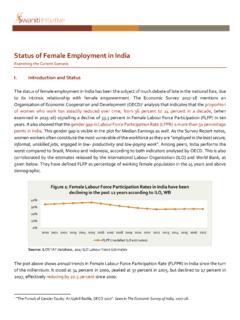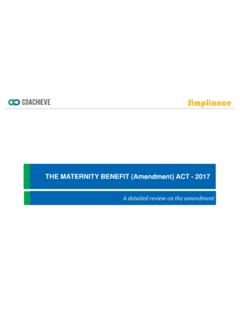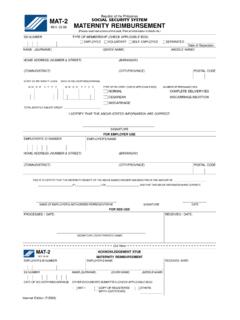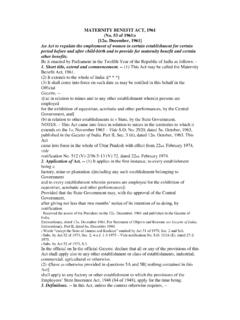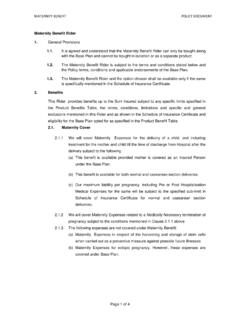Transcription of Status of Female Employment in India
1 Status of Female Employment in India Examining the Current Scenario I. Introduction and Status The Status of Female Employment in India has been the subject of much debate of late in the national fora, due to its intrinsic relationship with Female empowerment. The Economic Survey 2017-18 mentions an Organisation of Economic Cooperation and Development (OECD)1 analysis that indicates that the proportion of women who work has steadily reduced over time, from 36 percent to 24 percent in a decade, (when examined in 2015-16) signalling a decline of percent in Female Labour Force Participation (FLFP) in ten years.
2 It also showed that the gender gap in Labour Force Participation Rate (LFPR) is more than 50 percentage points in India . This gender gap is visible in the plot for Median Earnings as well. As the Survey Report notes, women workers often constitute the most vulnerable of the workforce as they are employed in the least secure, informal, unskilled jobs, engaged in low- productivity and low-paying work . Among peers, India performs the worst compared to Brazil, Mexico and Indonesia, according to both indicators analysed by OECD. This is also corroborated by the estimates released by the International Labour Organisation (ILO) and World Bank, as given below.
3 They have defined FLFP as percentage of working Female population in the 15 years and above demographic. Source: ILOSTAT database, 2017 ILO Labour Force Estimates The plot above shows annual trends in Female Labour Force Participation Rate (FLFPR) in India since the turn of the millennium. It stood at 34 percent in 2000, peaked at 37 percent in 2005, but declined to 27 percent in 2017, effectively reducing by percent since 2000. 1 The Pursuit of Gender Equity: An Uphill Battle, OECD 2017 . Seen in The Economic Survey of India , 2017-18.
4 0%10%20%30%40%20002001200220032004200520 0620072008200920102011201220132014201520 162017 Figure 1: Female Labour Force Participation Rates in India have been declining in the past 12 years according to ILO, WBFLFP (modelled ILO estimates) 2 2 To quote the Economic Survey 2017-18, which makes a case for gender equality, Addressing the meta-preference in favour of sons and empowering women with education and economic agency are critical challenges for the Indian economy . This statement brings out the cyclical nature of the problem: neglect of the born girl child leading to adverse health and education outcomes, which in turn, affects their economic productivity and capacity to contribute or earn an income, impacting adult women s mobility, decision-making power and social and eventual economic emancipation.
5 Therefore, women s Employment is critical for (1) instrumental reasons related to efficiency and productivity of the economy, as well as (2) the innate reason of women s empowerment. II. Low Female Employment in India : Reasons Due to the varied nature of the population composition and the differing statuses (both economic and social) which women enjoy across different states, the reasons for low Female Employment are varied. One of the chief problems which plague any analysis of Female Employment is the lack of government study on the Status on Female Employment in India .
6 While the National Sample Survey Organisation (NSSO) and Employment -Unemployment Survey (EUS) do provide state wise data in Female Employment , there is no study which identifies women friendly sectors state wise or provides reasons for declining Female Employment . The following analysis provides a general view of the reasons behind low Female Employment however theses reasons are hypothesis based on academia reports, a government study will go a long way in unearthing the forces which drive Female Employment and its counter, unemployment.
7 This analysis becomes all the more relevant as it is revealed that, in comparison to other South Asian countries, India does not perform well in terms of Female LFPR. For a period of ten years from 1990 to 2013, while Female LFPR has grown in countries like Bangladesh and Pakistan and stabilized in Sri Lanka, Female LFPR has declined in India by 6. 9 percentage points, from percent in 1990 to percent in 20132. A. Gender Differences: While an oft-cited reason leading to low economic empowerment of women, it is of paramount importance driving low Female Employment .
8 Gender differences and consequently preference for the male child and adult has an impact on the economic capacities of women from birth. Male preference and consequently low regard for females leads to inadequate health and education opportunities, from a very young age. Improper nutrition and lack of education deters women from being healthy contributing members of the work force. B. Access to Education leading to higher aspirations: While access to education for females has increased, many economists have theorized that as education empowers women, Employment choices for them become more stringent.
9 Both social norms and lack of quality Employment opportunities have an impact on the Employment options for women with secondary and tertiary education. However, this 2 ILO Report: new_delhi/documents/ , accessed as on 31st July, 2018 3 3 is more of any urban phenomenon, a significantly larger portion of women in the rural population are part of the work force. C. Lack of Quality Employment Opportunities: This reason is especially valid for rural regions, Employment opportunities in rural areas have not kept pace with the growth in the urban regions.
10 The Unemployment Rate (UR) for women in the rural population is 47/1000 which is significantly higher when compared to male UR standing at 21/10003. While domestic duties are a major impediment to any kind of Employment , few or the lack of major formal Employment opportunities for rural population have particularly hurt the progress of economic empowerment for females. Even entrepreneurship opportunities for rural population are hard to come due to lack of banking infrastructure in the far-flung areas and weak market linkages in others.

